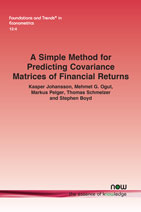A Simple Method for Predicting Covariance Matrices of Financial Returns
By Kasper Johansson, Department of Electrical Engineering, Stanford University, USA, kasperjo@stanford.edu | Mehmet G. Ogut, Department of Electrical Engineering, Stanford University, USA, giray98@stanford.edu | Markus Pelger, Department of Management Science and Engineering, Stanford University, USA, mpelger@stanford.edu | Thomas Schmelzer, Department of Electrical Engineering, Stanford University, USA, and Abu Dhabi Investment Authority, UAE, thomas.schmelzer@adia.ae | Stephen Boyd, Department of Electrical Engineering, Stanford University, USA, boyd@stanford.edu
Abstract
We consider the well-studied problem of predicting the timevarying covariance matrix of a vector of financial returns. Popular methods range from simple predictors like rolling window or exponentially weighted moving average (EWMA) to more sophisticated predictors such as generalized autoregressive conditional heteroscedastic (GARCH) type methods. Building on a specific covariance estimator suggested by Engle in 2002, we propose a relatively simple extension that requires little or no tuning or fitting, is interpretable, and produces results at least as good as MGARCH, a popular extension of GARCH that handles multiple assets. To evaluate predictors we introduce a novel approach, evaluating the regret of the log-likelihood over a time period such as a quarter. This metric allows us to see not only how well a covariance predictor does overall, but also how quickly it reacts to changes in market conditions. Our simple predictor outperforms MGARCH in terms of regret. We also test covariance predictors on downstream applications such as portfolio optimization methods that depend on the covariance matrix. For these applications our simple covariance predictor and MGARCH perform similarly.
A Simple Method for Predicting Covariance Matrices of Financial Returns
A Simple Method for Predicting Covariance Matrices of Financial Returns makes three contributions. First, it proposes a new method for predicting the time-varying covariance matrix of a vector of financial returns, building on a specific covariance estimator suggested by Engle in 2002. The second contribution proposes a new method for evaluating a covariance predictor, by considering the regret of the log-likelihood over some time period such as a quarter. The third contribution is an extensive empirical study of covariance predictors. The authors compare their method to other popular predictors, including rolling window, exponentially weighted moving average (EWMA) and generalized autoregressive conditional heteroscedastic (GARCH) type methods.
After an introduction, Section 2 describes some common predictors, including the one that this method builds on. Section 3 introduces the proposed covariance predictor. Section 4 discusses methods for validating covariance predictors that measure both overall performance and reactivity to market changes. Section 5 describes the data used in the authors’ first empirical studies and the results are provided in Section 6. The authors then discuss some extensions of and variations on the method, including realized covariance prediction (Section 7), handling large universes via factor models (Section 8), obtaining smooth covariance estimates (Section 9), and using the authors’ covariance model to generate simulated returns (Section 10).
